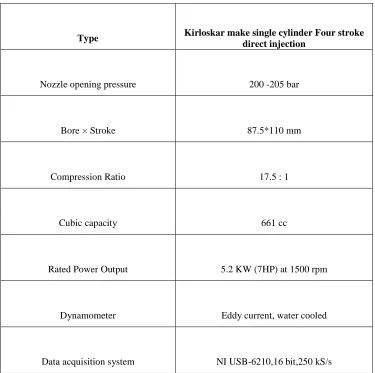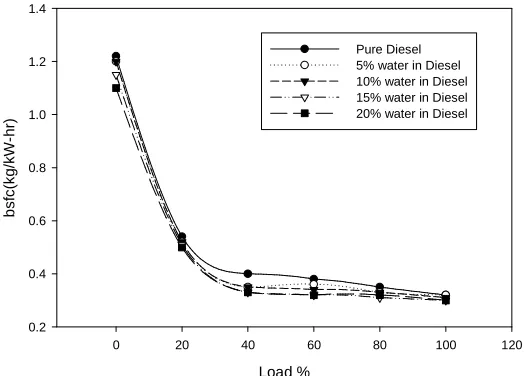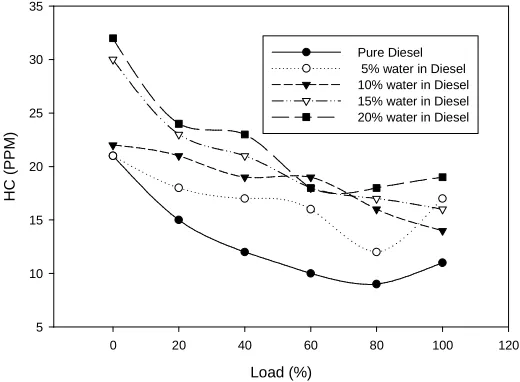E-ISSN: 2321-9637
Experimental Investigation of Emulsified Fuel in a Four
Stroke Diesel Engine for Performance, Combustion and
Emission
Narinder Singh
1and R. S.Bharj
2Department of Mechanical Engineering, National Institute of Technology, Jalandhar 144011, INDIA Email: n.narindersingh@rediffmail.com1,bharjrs@nitj.ac.in2
Abstract- Emulsion of water diesel has been used in a single cylinder water cooled four stroke diesel engine. Stable emulsions are produced using water in the ratio of 5, 10, 15 and 20% by volume in diesel. Tween 80 and Span 80 with a HLB balance of 8 are used as surfactant. Emulsions are prepared in a mechanical homogeniser at the speed of
3000 rpm for duration of 25 minutes. The experimentation is carried out using single cylinder diesel engine
equipped with data acquisition system. An AVL Di-gas analyser and AVL smoke opacity meter has been used to measure the exhaust emissions. Experiments are carried out at a constant speed of 1500 rpm from no load to full
load for all fuel specimens. Combustion characteristics such as rate of pressure rise, net heat release rate, brake
specific fuel consumption, brake thermal efficiency are recorded for pure diesel and various emulsions. Emission
parameters such as NOx, CO, HC, CO2 and smoke opacity arealso measured. The results shows increase in the rate
of pressure rise, net heat release rate consequently longer delay period, however increase in performance and reduction in emissions takes place using emulsified fuel.
Keywords: Diesel engine; Water-diesel emulsions, Exhaust emission; Performance.
1. INTRODUCTION
Diesel engines dominate over other engines in transportation, heavy industries and agricultural sectors due to economy and part load efficiency. On the other hand, conventional CI diesel engines produce high emissions of nitric oxides (NOx), carbon monoxide
(CO), carbon dioxide (CO2), unburned hydrocarbon
(HC), smoke and other harmful compound [1]. Many efforts have been made to find the solution to these emissions. As Government is implementing strict emissions norms, the emissions reduction is a major research objective. Emulsification is one of the methods to reduce CI engine emissions without making any modification in the engine design. In water diesel emulsion the presence of water vapor has a beneficial effect on the rate of heat release and reduces the pollutants emission. The presence of water vapor in reactants influences the physics and chemical kinetics of combustion. During combustion, water reduces the
flame temperature and changes the chemical
composition of the reactants which subsequently, control the NO formation and soot oxidation [2-6]. Emulsification process mixes immiscible materials like water and oil, and maintains a temporary suspension reducing their particulate sizes. According to the types, viscosities, particulate size, composition and the temperature emulsion returns to a two- phase mixture [7-8]. A theoretical study on the combustion of emulsified fuel favors the combination of a high
pressure environment and a high boiling temperature fuel in enhancing smoke reduction [9]. So water diesel emulsions are particularly suitable for applications in Diesel engines, where a non-volatile fuel is used, and the specific fuel consumption and thermal efficiency due to the reduction in heat losses [16].
The present work is focused to establish the effects on the combustion, emission and the performance of a single cylinder direct injection diesel engine using water diesel emulsion in the ratio of 5%, 10%, 15% and 20%. Henceforth, the current investigation is dedicated to establish the use of the water diesel emulsion on the combustion, performance and emission characteristics of a direct injection single cylinder diesel.
E-ISSN: 2321-9637
2. EXPERIMENTATIONS DETAIL
2.1 Use of emulsified fuel
For preparing emulsion of different compounds having different properties a surfactant or binding substance is needed. In this experiment mixture of Span 80 and Tween 80 are used as surfactant. Mixture is prepared by both surfactants with a HLB balance of 8.Pure diesel with a cetane index of 47 is used to
prepare emulsified fuel. Complete process of
preparation of emulsified fuel is discussed in section test fuel and methods.
2.2 Experimental apparatus
Single-cylinder Direct Injection (DI) water-cooled diesel engine used for experimentation is equipped with data acquisition system to analyse the performance and combustion characteristics using different fuel specimens. The schematic layout of the experimental setup is shown in Fig.1. Engine specifications are listed in Table 1. Exhaust emissions are measured by an AVL Di-gas analyser i.e. carbon monoxide, carbon dioxide, hydrocarbon and oxides of nitrogen. The AVL smoke opacity meter is used to measure the smoke opacity. AVL Di-gas analyser (model AVL Di-gas 4000 light) and smoke opacity meter (model AVL 437) used are shown in Fig. 2 and 3.
Fig. 1. Single cylinder diesel engine test rig
E-ISSN: 2321-9637
The experiments are performed at a constant rated speed of 1500 rpm with a fixed compression ratio of 17.5: 1 at
constant injection timing of 230 before top dead center.
Results are obtained by varying the loads from 0% to 100% load and repeated three times for all kind of fuel specimens in order to increase the reliability of test
results. Each test is conducted by flushing out the previous fuel then putting the new fuel to maintain the accuracy of the results. During the tests, the parameters such as brake thermal efficiency, brake specific fuel consumption, cylinder pressure rise rate, and heat release rate are recorded on the computer and analyzed.
Table 1 Engine specifications
Type Kirloskar make single cylinder Four stroke direct injection
Nozzle opening pressure 200 -205 bar
Bore × Stroke 87.5*110 mm
Compression Ratio 17.5 : 1
Cubic capacity 661 cc
Rated Power Output 5.2 KW (7HP) at 1500 rpm
Dynamometer Eddy current, water cooled
Data acquisition system NI USB-6210,16 bit,250 kS/s
2.3 Test fuels and methods
Four specimens of emulsified fuels in the ratio of 5%, 10%, 15% and 20% by volume of water in diesel were prepared in this study. Diesel fuel used in the work has a cetane index of 47. Surfactant mixture is prepared
E-ISSN: 2321-9637
Fig. 4 Mechanical homogenizer
Fig. 5 Samples of water diesel emulsions by ratio of 5%, 10%, 15% and 20% of water in diesel
For preparing emulsion of different compounds having different properties a surfactant or binding substance is needed. The conventional surfactants used in this study are span 80 (sorbitan monooleate) hydrophobic in nature and Tween 80 (polyxyethylene sorbitan monooleate) hydrophilic in nature. The surfactant mixture is prepared by mixing the two surfactants 2%
E-ISSN: 2321-9637
Table 2 Tested fuel Properties and stability period
Properties of
emulsions METHOD UNITS (PD)0%W 5%W 10%W 15%W 20%W
Density@20oC
(Kg/m3) ASTM D7042 g/cc 0.83101 0.83755 0.84643 0.85317 0.86266
API Density@15oC
(Kg/m3)
ASTM D7042 g/cc 0.83227 0.84118 0.85002 0.85674 0.86818
Kinematic Viscosity@40oC
(Cst)
ASTM D7042 Cst 2.72 3.15 3.34 3.632 4.829
Specific
gravity@20oC ASTM D445-12 - 0.83009 0.83905 0.84794 0.85470 0.86622
Flash point (oC) ASTM D92 0C 58 60 62 63.5 65
Fire point (oC) ASTM D92 0C 71 71.5 72 75 76
Calorific value ASTM D240 MJ 42.9 41.5 40 39.2 38.1
Cetane index ASTM D4737 - 47 46 45 44 42
Stability Period - Days Stable 7 7 6 5
3. RESULTS AND DISCUSSIONS
Pure diesel, water diesel emulsions by ratio of 5%,
10%, 15% and 20% of water are investigated regarding
combustion, performance and emission aspects. In the
combustion part, pressure rise in the cylinder, heat
release rate are analyzed. The performance parameters
such as brake specific fuel consumptions, brake thermal
effiency and emission characteristics such as oxides of
nitrogen , carbon dioxide ,carbon monoxide,
hydrocarbon and smoke opacity are analyzed and discussed.
E-ISSN: 2321-9637
In the combustion aspect of water diesel emulsion, rate of pressure rise and heat release rate are plotted against the crank angle.
Rate of pressure rise for pure diesel Rate of pressure rise for 5% water in diesel
Rate of pressure rise for 10 % water in diesel Rate of pressure rise for 15 % water in diesel
Rate of pressure rise for 20 % water in diesel
E-ISSN: 2321-9637
Rate of pressure rise in the cylinder for pure diesel, 5%, 10%, 15% and 20% water in diesel are shown in Figure 6. It is observed that rate of pressure rise in the cylinder for 15% water in diesel is high compared to pure diesel. It is increased as the ratio of water in the fuel specimen
increased. It is also observed that net heat release rate
also increased as the ratio of water in the fuel specimen increased as compared to pure diesel; it may be due to
the enhanced premixed combustion resulted by longer
ignition delay [19] The observed net heat release rate
for 15% water diesel emulsion was 79 J/deg. in comparison to 62 J/deg. for pure diesel (as shown in
Fig. 7). Noise level observed in the case of 20% water
in diesel is high and engine operation is also not smooth enough. Longer ignition delay period in water diesel emulsion aggravate this.
Net heat release rate for pure diesel Net heat release rate for 5% water in diesel
Net heat release rate for 10 % water in diesel Net heat release rate for 15 % water in diesel
Net heat release rate for 20 % water in diesel
E-ISSN: 2321-9637
3.2 Performance and emissions
3.2.1 Variation of Specific fuel consumption with load Variation of specific fuel consumption (SFC) for the pure diesel and different emulsions are shown in Fig. 8. SFC decrease with engine loads considering the emulsion (diesel water) as total fuel. It shows that SFC decreases as engine load increases, this is due to fact that more water works as fuel as more water takes space of diesel in burning process. The reduction in SFC with
water emulsified diesel may also be attributed to formation of a finer spray due to rapid evaporation in the water. Longer ignition delay contributes towards more fuel burning in premixed combustion and suppression of thermal dissociation due to lower cylinder average temperature. Brake specific fuel consumption observed at full load is 0.30 kg/kW-hr for 20% water diesel emulsion, whereas it is 0.32 for the
Fig. 8 Variation of SFC with Load
3.2.2 Variation of brake thermal efficiency with load
Fig. 9 shows the effect of emulsified fuel on the brake thermal efficiency. The maximum brake thermal efficiency of 28.6 % is achieved when 15 % water
E-ISSN: 2321-9637
Fig. 9 Variation of Brake Thermal Efficiency with Load
3.2.3 Variation of NOx with load
The variation of NOx with engine load using different fuel specimens is shown in Fig. 10. It is clear that as the water in diesel is added, the exhaust temperature decreases as the heat is absorbed by the additional water, which subsequently decrease the NOx as it is the product of reaction of nitrogen with oxygen at higher temperature. The latent heat of water will cool
the charge due to the evaporation of water, and the cylinder average temperature following injection and
before ignition becomes lower due to the water. NOx
concentration increased at higher load due to the conversion of nitrogen to NO at high gas temperature by
combining with O2 to form NOx [20]. It is observed that
NOx produced at full load by 5%, 10%, 15%, 20% water diesel emulsion and pure diesel is 410ppm, 400ppm, 400ppm, 390ppm and 428ppm respectively.
L o a d ( % )
E-ISSN: 2321-9637
3.2.4 Variation of Carbon dioxide with load
Carbon dioxide reflects complete combustion of fuel. Combustion of emulsified fuel shows increasing trend with the increase of percentage of water. It gives
justification for complete combustion of fuel in case of emulsions compared to pure diesel Fig. 11 illustrates the complete trend of variation of Carbon dioxide for different fuel specimens at different loads.
Load (%)
Fig. 11 Variation of Carbon dioxide with Load
3.2.5 Variation of Carbon monoxide with load
Carbon monoxide is a result of incomplete combustion. It has been observed that emission of CO increases with increase in volume of water in the emulsion. This happens because water helps in micro explosion of fuel and more oxygen supplied by the added water. It is also
observed that when the load is increased CO concentration increases for all the samples and pure diesel. It is also observed that when the load is increased CO concentration increases for all the fuel specimens. CO produced by 5%, 10%, 15% and 20% water diesel emulsion is significantly more compared to pure diesel as shown in the Fig. 12.
E-ISSN: 2321-9637
3.2.6 Variation of HC with load
HC is produced when fuel move to the exhaust without doing the work or not getting proper oxygen for burning. Fig. 13 has shown the variation of HC with load. It is observed that HC increased, with water diesel
emulsion due to reduction in gas temperature and incomplete combustion. The magnitude of HC observed at full load by 5%, 10%, 15% and 20% water diesel emulsion and pure diesel is 17ppm, 14ppm, 16ppm, 19ppm and 11ppm respectively.
Load (%)
0 20 40 60 80 100 120
H
C
(
P
P
M
)
5 10 15 20 25 30 35
Pure Diesel 5% water in Diesel 10% water in Diesel 15% water in Diesel 20% water in Diesel
Fig. 13 Variation of HC with Load
3.2.7 Variation of Smoke with load
Smoke is the result of incomplete combustion. Tiny unburned particles mostly carbon soot collected in the exhaust produce smoke. As combustion is improved in the water diesel emulsion, smoke is reduced
E-ISSN: 2321-9637
Fig. 14 Variation of smoke with Load
4. CONCLUSIONS
On the basis of the experimental results investigated on single cylinder direct injection diesel engine using pure diesel and emulsified fuel with different ratios of water the following conclusions are drawn:
2) Rate of pressure rise in the cylinder for 15% water diesel emulsion is high compared to pure diesel. It is also observed that net heat release rate for the 5%,10%,15% and 20% water diesel emulsion is high compared to pure diesel; it is due to the enhanced premixed combustion resulted by longer ignition. 3) The brake specific fuel consumption was observed to decrease with water diesel emulsion. Result shows that specific fuel consumption at full load is 0.30 kg/kW-hr for 20% water diesel emulsion, whereas it is 0.32, 0.31, 0.30 and 0.32 for 5%, 10%, 15% and pure diesel. 4) The brake thermal efficiency of emulsified fuel increases with increase in water concentration in the emulsion at all the loads. The brake thermal effiency at full load observed for 15% water diesel emulsion is 28.6 and for 5%, 10%, 20% water diesel emulsion and Pure Diesel is 27.9, 28, 28.5 and 27.9 respectively.
5) The NOx emission is reduced significantly with the use of emulsified fuel. This trend goes on increasing with increase in amount of water in the emulsion. NOx emission observed at full load during the investigation found to be 390ppm for 20% water diesel emulsion and for 5%, 10%, 15% water diesel emulsion, Pure Diesel it is 410ppm, 400ppm, 400ppm,428ppm.
6) Hydrocarbon emissions shows increasing trend with emulsified fuel as compared to diesel. Lowest HC produced by pure diesel is 11ppm however it is highest of 19ppm when using 20% water diesel emulsion. When the load increases HC emissions are higher for water diesel emulsion.
7) Carbon monoxide emissions increase with increase in ratio of water in emulsified fuel. However carbon dioxide shows increasing trend with emulsified fuel due to uniform combustion. diesel blend fuel, Fuel, Vol.83, pp. 2013–2020.
E-ISSN: 2321-9637
and Emission Characteristics of Three-phase Diesel Emulsions Prepared by an Ultrasonic Emulsification Method. Taiwan Fuel, vol.85, pp. 593–600.
[4] Ghojel, J., Honnery, D., and Al-Khaleefi, K.
(2006): Performance, emissions and heat release characteristics of direct injection diesel engine operating on diesel oil emulsion. Application Thermal Engineering, vol. 26, pp. 2132– 2141.
[5] Kadota T, Yamasaki H. (2002): Recent advances
in the combustion of water fuel emulsion. Programme Energy Combustion Science, vol. 28, pp. 385–404.
[6] Samec N, Kegl B, Dibble R. (2002): Numerical
and experimental study of water/oil emulsified fuel combustion in a diesel engine. Fuel, vol. 81, pp. 2035–44.
[7] Schulz P, Dalix L, Letoffe J M & Faure Y,
INSEDELF (2004): Method of studying separation in liquid–liquid phase application to water– diesel fuel emulsions. Fuel, v o l . 83, pp.137–
water/oil emulsion droplets. Combust Sci Technol 17:29. Emulsions Preparation in Helical Flow, Turkish J. Eng. Env. Sci., vol. 30, pp. 175-182.
[12] Piaseczny L & Zadrag R, (2005): Researches of
influence of water delivery to cylinder on parameters of combustion process and toxicity of CI engine, Proceeding of Polish Congress-
PTNSS, Bielsko Biala/Szczyrk, September,
Poland, 2005.
[13]J.W. Park, K.Y. Huh, J.H. Lee. (2001): Reduction
of NOx, smoke and brake specific fuel consumption with optimal injection timing and emulsion ratio of water-emulsified diesel. Proc. Instn. Mech. Engrs. vol.215, pp. 83-93.
[14] Abu-zaid M, (2004): An experimental study
of the evaporation characteristics of emulsified liquid droplets, Heat Mass Transfer, vol. 40, No. 9, pp.737-741.
[15] Selim M Y E & Ghannam M T, (2009):
Combustion study of stabilized water-in-diesel fuel emulsion, Energy Sources, Part A: Recovery, Utilization, and Environmental Effects, vol. 32,
No. 3, pp. 256-274.
[16] Alahmer A, Yamin J, Sakhrieh A & Hamdan M,
(2009): Engine performance using emulsified diesel fuel. Energy Con. Manage., vol. 51, No. 8, pp. 1708-1713.
[17]Rosen, M.J. (2004): Surfactants and interfacial
phenomena. New York, 3rd edition, Wiley, Interscience.
[18]Lin, C.Y., and L.-W. Chen. (2008):Comparison of
fuel properties and emission characteristics of two
and three-phase emulsions prepared by
ultrasonically vibrating and mechanically
homogenizing emulsification methods. Fuel, vol. 87, pp. 2154–61.
[19]Subramanian, K.A., and A. Ramesh. (2002): Use
of diethyl ether along with water-diesel emulsion in a DI diesel engine. SAE paper No. 2002-01-2720.
[20]C.Y. Lin, L.W. Chen. (2006): Engine Performance
and Emission Characteristics of Three-phase Diesel Emulsions Prepared by an Ultrasonic Emulsification Method. Taiwan Fuel, vol.85, pp. 593–600.
[21]C.Y. Lin, K.H. Wang. (2004): Effects of a
Combustion Improver on Diesel Engine









